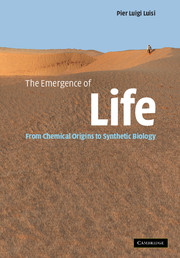Book contents
- Frontmatter
- Contents
- Preface
- Acknowledgments
- List of books on the origin of life
- 1 Conceptual framework of research on the origin of life on Earth
- 2 Approaches to the definitions of life
- 3 Selection in prebiotic chemistry: why this … and not that?
- 4 The bottle neck: macromolecular sequences
- 5 Self-organization
- 6 The notion of emergence
- 7 Self-replication and self-reproduction
- 8 Autopoiesis: the logic of cellular life
- 9 Compartments
- 10 Reactivity and transformation of vesicles
- 11 Approaches to the minimal cell
- Outlook
- References
- Index
11 - Approaches to the minimal cell
Published online by Cambridge University Press: 17 December 2010
- Frontmatter
- Contents
- Preface
- Acknowledgments
- List of books on the origin of life
- 1 Conceptual framework of research on the origin of life on Earth
- 2 Approaches to the definitions of life
- 3 Selection in prebiotic chemistry: why this … and not that?
- 4 The bottle neck: macromolecular sequences
- 5 Self-organization
- 6 The notion of emergence
- 7 Self-replication and self-reproduction
- 8 Autopoiesis: the logic of cellular life
- 9 Compartments
- 10 Reactivity and transformation of vesicles
- 11 Approaches to the minimal cell
- Outlook
- References
- Index
Summary
Introduction
We come back now to the origin of life and the evolution of early cells. We have seen in the first chapters of this book the endeavor of people working with the aim of clarifying the pathway to the transition to life starting from simple molecules. This is the so-called bottom-up approach, the narrative by which a continuous and spontaneous increase of molecular complexity has transformed inanimate matter into the first self-reproducing entities, and from those, life at large.
The bottle neck of the bottom-up approach is the difficulty of reproducing on paper and/or in the laboratory those processes which have been moulded by contingency – such as the synthesis of specific macromolecular sequences.
There is another approach to the construction of the living cell, as indicated in Figure 11.1. This is to utilize the extant nucleic acids and enzymes and insert them into a vesicle, and re-construct in this way a minimal living cell.
Whereas the term “bottom-up” is recognized and accepted, the terminology of this alternative route to the minimal cell is less clear. The term “top-down” has been utilized by my group, mostly to set up a discrimination with respect to the bottom-up approach; however such a terminology is not really correct. In fact, this is also a bottom-up approach, in the sense that it goes in the direction of increasing complexity (the cell) starting from the single components.
Information
- Type
- Chapter
- Information
- The Emergence of LifeFrom Chemical Origins to Synthetic Biology, pp. 243 - 267Publisher: Cambridge University PressPrint publication year: 2006
